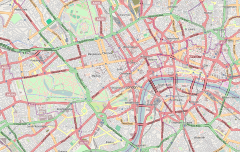| Palace of Westminster | |
|---|---|
 | |
| General information | |
| Architectural style | Perpendicular Gothic Revival |
| Address | Westminster London SW1A 0AA United Kingdom |
| Coordinates | 51°29′57″N 00°07′29″W / 51.49917°N 0.12472°W |
| Year(s) built |
|
| Destroyed | 1834 (due to fire) |
| Owner | King Charles III in right of the Crown[1] |
| Technical details | |
| Floor area | 112,476 m2 (1,210,680 sq ft)[2] |
| Design and construction | |
| Architect(s) | Charles Barry and Augustus Pugin |
| Official name | Palace of Westminster, Westminster Abbey, and St Margaret's Church |
| Type | Cultural |
| Criteria | i, ii, iv |
| Designated | 1987 (11th session) |
| Reference no. | 426 |
| Country | United Kingdom |
| Region | Europe |
| Extensions | 2008 |
Listed Building – Grade I | |
| Official name | Houses of Parliament and The Palace of Westminster |
| Designated | 5 February 1970 |
| Reference no. | 1226284 |
The Palace of Westminster is the meeting place of the Parliament of the United Kingdom and is located in London, England. It is commonly called the Houses of Parliament after the House of Commons and the House of Lords, the two legislative chambers which occupy the building. The palace is one of the centres of political life in the United Kingdom; "Westminster" has become a metonym for the UK Parliament and the British Government, and the Westminster system of government commemorates the name of the palace. The Elizabeth Tower of the palace, nicknamed Big Ben, is a landmark of London and the United Kingdom in general. The palace has been a Grade I listed building since 1970 and part of a UNESCO World Heritage Site since 1987.
The building was originally constructed in the eleventh century as a royal palace and was the primary residence of the kings of England until 1512, when a fire destroyed the royal apartments. The monarch moved to the adjacent Palace of Whitehall, but the remainder of the palace continued to serve as the home of the Parliament of England, which had met there since the 13th century. In 1834 a second, larger fire destroyed the majority of the palace, but Westminster Hall was saved and incorporated into the replacement building.
The competition to design the new palace was won by the architect Charles Barry, who chose a Gothic Revival style for the building. Construction started in 1840 and lasted for 30 years, suffering delays, cost overruns, and the deaths of Barry and his assistant, Augustus Pugin. The palace contains chambers for the House of Commons, House of Lords, and the monarch, and has a floor area of 112,476 m2 (1,210,680 sq ft).[2] Extensive repairs had to be made after the Second World War, including rebuilding the destroyed Commons chamber. Despite further conservation work having been carried out since, the palace is in urgent need of major repairs.
- ^ "Planning (Application to the Houses of Parliament) Order 2006". Parliamentary Debates (Hansard). Vol. 682. United Kingdom: House of Lords. 17 May 2006. col. 339.
The Palace of Westminster is therefore Crown land because it is land in which there is a Crown interest, in this case an interest belonging to Her Majesty in right of the Crown.
- ^ a b "Palace of Westminster: Factsheet" (PDF). Restoration and Renewal. Houses of Parliament. Archived from the original (PDF) on 14 September 2017. Retrieved 13 September 2017.
